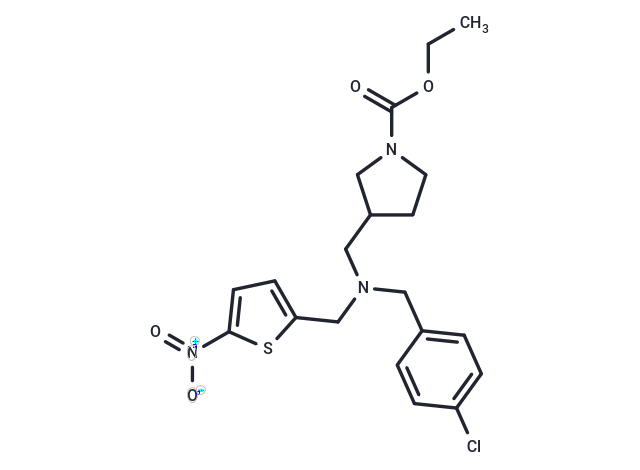 Your shopping cart is currently empty
Your shopping cart is currently empty

SR9009 (Stenabolic), a REV-ERB agonist, increases the constitutive repression of genes regulated by REV-ERBα/ERBβ (IC50: 670/800 nM). Through activation of REV-ERB, SR9009 can decrease circadian locomotor activity during the dark phase and alter the expression pattern of core clock genes in the hypothalami of mice. The circadian pattern of expression of an array of metabolic genes in the liver, skeletal muscle, and adipose tissue was also altered in mice exposed to SR9009, resulting in increased energy expenditure. In Diet-induced obese mice, SR9009 (100 mg/kg, i.p., b.i.d., for 30 days) could decrease fat mass and markedly improve dyslipidemia and hyperglycemia.

| Pack Size | Price | USA Warehouse | Global Warehouse | Quantity |
|---|---|---|---|---|
| 2 mg | $35 | In Stock | In Stock | |
| 5 mg | $56 | In Stock | In Stock | |
| 10 mg | $89 | In Stock | In Stock | |
| 25 mg | $147 | In Stock | In Stock | |
| 50 mg | $263 | In Stock | In Stock | |
| 100 mg | $427 | In Stock | In Stock | |
| 200 mg | $632 | In Stock | In Stock | |
| 1 mL x 10 mM (in DMSO) | $62 | In Stock | In Stock |
| Description | SR9009 (Stenabolic), a REV-ERB agonist, increases the constitutive repression of genes regulated by REV-ERBα/ERBβ (IC50: 670/800 nM). Through activation of REV-ERB, SR9009 can decrease circadian locomotor activity during the dark phase and alter the expression pattern of core clock genes in the hypothalami of mice. The circadian pattern of expression of an array of metabolic genes in the liver, skeletal muscle, and adipose tissue was also altered in mice exposed to SR9009, resulting in increased energy expenditure. In Diet-induced obese mice, SR9009 (100 mg/kg, i.p., b.i.d., for 30 days) could decrease fat mass and markedly improve dyslipidemia and hyperglycemia. |
| Targets&IC50 | Rev-Erbα:670 nM, Rev-Erbβ:800 nM |
| In vitro | SR9009 effectively inhibits transcription in a cotransfection assay using full-length REV-ERBα along with a luciferase reporter driven by the Bmal1 promoter (SR9009 IC50: 710 nM). SR9009 suppresses the expression of BMAL1 mRNA in HepG2 cells in a REV-ERBα/β-dependent manner. |
| In vivo | SR9009 inhibits the activity of the SCN clock, with reversible inhibition of circadian oscillations in SCN explants cultured from the Per2: Luc reporter mouse. |
| Cell Research | SR9009 is dissolved in DMSO and diluted with appropriate media[1]. HEK293 cells are grown in 96-well plates (1×106/well) and are transiently transfected using Lipofectamine. Cells are transfected with a total of 200 ng of DNA per well consisting of the pGL4 mIL-17 firefly luciferase reporter construct, the pGL4 mIL-17 + CNS-5 firefly luciferase reporter construct, or the pGL4 mIL-17 2kB RORE mutant (100 ng/well) , an actin promoter Renilla reniformis luciferase reporter (50 ng/well), and either control vector alone or the test DNA (full-length RORα or full-length RORγ at 50 ng/well). All 48 human nuclear receptors are represented in the specificity assay and SR9009 is tested at a concentration of 20 μM. The format of the assay is a cotransfection assay with Gal4 DNA binding domain-nuclear receptor fusions in HEK293 cells[1]. |
| Synonyms | Stenabolic, REV-ERB Agonist II |
| Molecular Weight | 437.94 |
| Formula | C20H24ClN3O4S |
| Cas No. | 1379686-30-2 |
| Smiles | CCOC(=O)N1CCC(CN(Cc2ccc(s2)[N+]([O-])=O)Cc2ccc(Cl)cc2)C1 |
| Relative Density. | 1.327 g/cm3 (Predicted) |
| Color | White |
| Appearance | Solid |
| Storage | store at low temperature | Powder: -20°C for 3 years | In solvent: -80°C for 1 year | Shipping with blue ice/Shipping at ambient temperature. | |||||||||||||||||||||||||||||||||||
| Solubility Information | DMSO: 252 mg/mL (575.42 mM), Sonication is recommended. | |||||||||||||||||||||||||||||||||||
| In Vivo Formulation | 10% DMSO+90% Corn Oil: 3.3 mg/mL (7.54 mM), Sonication is recommeded. Please add the solvents sequentially, clarifying the solution as much as possible before adding the next one. Dissolve by heating and/or sonication if necessary. Working solution is recommended to be prepared and used immediately. The formulation provided above is for reference purposes only. In vivo formulations may vary and should be modified based on specific experimental conditions. | |||||||||||||||||||||||||||||||||||
Solution Preparation Table | ||||||||||||||||||||||||||||||||||||
DMSO
| ||||||||||||||||||||||||||||||||||||
| Size | Quantity | Unit Price | Amount | Operation |
|---|

Copyright © 2015-2026 TargetMol Chemicals Inc. All Rights Reserved.